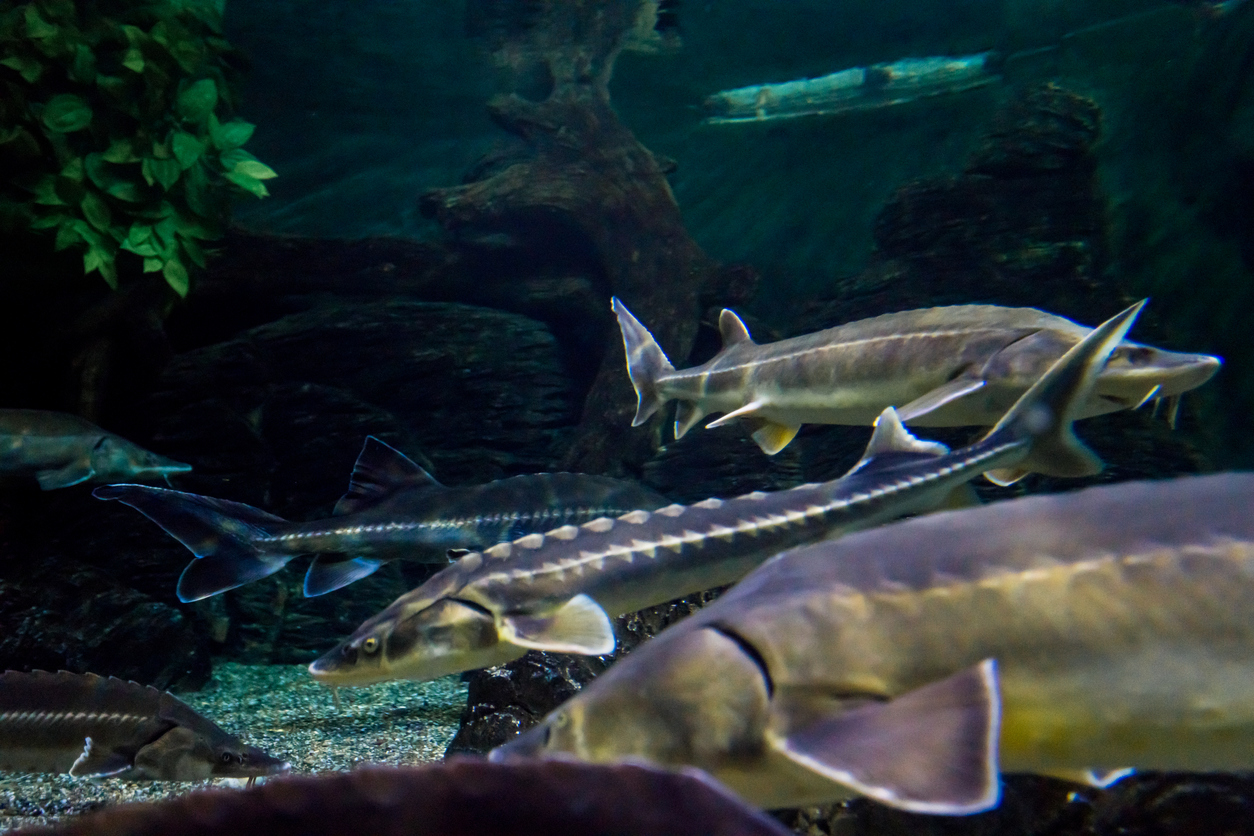Sturgeon farm
Sturgeon breeding has been a speciality of Fischgut Primus for years. Therefore we can always offer many different types in different sizes. Because of its boneless flesh and roe (caviar), the sturgeon was tried to produce primarily as food fish. However, due to a lack of experience in sturgeon breeding, there were initially many problems that had to be overcome. Problems that almost every pond owner knows about nowadays. These include fish eating birds, lack of special food and thread algae.
For the highest possible level of hygiene, our system is divided into different compartments. Starting from the place of reproduction, over hatcheries, various circulation systems, as well as several large tanks where fish of all sizes and colours can swim. For reasons of fish hygiene, all circuits operate separately and exclusively with well water. The individual circuits are equipped with large filters, trickling filters and UV systems in order to achieve the best possible water quality. Our solar system allows us to bring the water temperatures in each circuit to the desired temperature.
In addition, artificial reproduction is extremely difficult and production costs are currently disproportionately high thanks to the increasing number of water areas in Germany, including the creation of ponds for ornamental fish and Koi, as well as its unusual appearance and its little pronounced escape reflex, the sturgeon is now increasingly used in ponds.
Eine Spezialität des Fischgut Primus ist seit Jahren die Störzucht. Daher können wir stets viele verschiedene Arten in unterschiedlichen Größen anbieten. Auf Grund seines grätenlosen Fleisches und des Rogens (Kaviar), wurde versucht den Stör vorrangig als Speisefisch zu produzieren. Doch durch fehlende Erfahrungswerte in der Störzucht gab es anfänglich viele Probleme, die überwunden werden mussten. Probleme, die heutzutage nahezu jeder Teichbesitzer kennt. Dazu zählen, u.a. fischfressende Vögel, fehlendes Spezialfutter und Fadenalgen.
Für eine möglichst hohe Hygiene ist unsere Anlage in verschiedene Abteile abgetrennt. Angefangen vom Ort der Reproduktion, über Bruträume, verschiedenste Kreislaufanlagen, sowie etliche Großbecken wo Fische aller Größe und Farbe schwimmen können. Aus Gründen der Fischhygiene arbeiten alle Kreisläufe getrennt von einander und ausschließlich mit Brunnenwasser. Die einzelnen Kreisläufe sind mit großen Filtern, Tropfkörpern und UV-Anlagen ausgestattet, um eine möglichst gleichbleibend gute Wasserqualität zu erreichen. Über unsere Solaranlage können wir die Wassertemperaturen in jedem Kreislauf auf die gewünschte Temperatur bringen.
Zusätzlich stellt sich die künstliche Vermehrung als außerordentlich schwierig dar, und die Produktionskosten sind derzeit unverhältnismäßig hoch.Dank der in Deutschland immer größer werdenden Zahl von Wasserflächen, auch durch das Anlegen von Teichanlagen für Zierfische und Koi, sowie wegen seiner außergewöhnlichen Erscheinung und seines wenig ausgeprägten Fluchtreflexes wird der Stör heute zunehmend mehr in Teichanlagen eingesetzt.
Our sturgeon species at a glance
Today, the following sturgeon species are kept in the fish stock, of which certainly not every species has anything to do with large ponds or garden ponds, such as the houses as predatory fish in the koi pond or the spoon sturgeon, which finds no plankton to filter in the crystal-clear koi pond.
Today, the following sturgeon species are kept in the fishgut, of which certainly not every species has anything to do with large ponds or garden ponds, such as the houses as predatory fish in the koi pond, or the spoon sturgeon, which finds no plankton to filter in the crystal-clear koi pond.Of which certainly not every species has something to look for in large ponds or garden ponds, mention should be made of the houses as predatory fish in the koi pond, or the paddlefish sturgeon, which finds no plankton to filter in the crystal-clear koi pond. Some of these sturgeon species are also reproduced, which was only possible thanks to the latest hot-water hatchery technology.
The different types of sturgeon differ in appearance, but also in their behaviour in natural surroundings as well as in ponds. This means that anyone who wants to buy a sturgeon can get the most suitable species for their needs. It goes without saying that the clearer the water, the better the chance of seeing darker coloured sturgeon species.
Siberian sturgeon is relatively easy to propagate, grows quickly and is very popular as a food fish because of its good meat quality. It finds however by its favourable price ever more approval with pond owners, although it is quite uninteresting as a basic inhabitant with a simple dark appearance in the pond.
The Sternhausen has perhaps the most beautiful body drawing, since it has bright speckles everywhere in addition to the white rows of bone plates. In addition, the “duck’s beak” rostrum (snout) gives it a special appearance and is a good distinguishing characteristic to the wax thick.
As one of the smallest representatives of sturgeon, the sterlet is also interesting for medium-sized ponds. The sturgeon, which used to be native here, is brownish in colour with many small bone plates and white fin seams.
It quickly becomes sexually mature and is often used as a parent for hybrids. As the only sturgeon species it is viable with albinism and is then a special attraction as a snow-white sturgeon in the pond.
Adriatic sturgeon and white sturgeon have a very similar appearance. As full-grown animals they can become very large and are therefore only suitable for large waters. Sexually mature fish of these sturgeon species are present in the Primus fish stock with specimens of 30 to 200 kg.
The Waxdick is probably one of the most interesting sturgeon as pond fish, since it has a very contrasting body colouring. The fish is mostly at the bottom, but includes the shore in the search for food. Fischgut-Primus – sturgeon – sturgeon farming
Like all young sturgeons, young wax thick have big problems with filamentous algae, but larger ones no longer, quickly become tame and even eat out of their hands. Today they are one of the most sought-after sturgeon species, even in ponds.
The insensitivity of sturgeon to diseases and parasites and the wide range of water temperatures in which the fish still feel comfortable are also worth mentioning. Sturgeons naturally feed on soil organisms such as mussels, snails, worms and small crustaceans. However, most sturgeon species can be easily converted to “artificial” food, which makes feeding sturgeon in ponds much easier. In sturgeon farming we only use sturgeon feed (no trout feed), because we were able to achieve the best results in terms of fish health and growth. The suitable food for your sturgeon can of course be obtained from our fish in various grain sizes and units of measure. Some sturgeons are now being bred, and that is a good thing. All 24 sturgeon species still occurring worldwide are threatened with extinction. But also thanks to the private boom of sturgeon as pond fish, many species are artificially propagated, which in turn benefits the remaining natural populations. On the one hand, these can remain untouched and, in addition, the sturgeon farms are often coupled with reintroduction programmes of native sturgeon species. When dealing responsibly with sturgeon, as it should be with Koi, you will enjoy the sturgeon in the pond. However, when choosing the sturgeon species, it is important to remember that they are also selected to suit the water body. Because sturgeons can grow very large.
Food

CONTACT
Adress
In der Bräke 8
D-58644 Iserlohn
Phone & E-Mail
+49 (0) 2371 – 510 43
info@fischgut-primus.de
Opening hours
Monday - Tuesday: day of rest
Wednesday - Thursday: 13:30 - 18:00 o'clock
Friday: 10:00 - 18:00 o'clock
Saturday: 10:00 - 13:00 o'clock
Sunday: 10:00 - 13:00 o'clock
Of course, you can also pick up orders outside opening hours by telephone arrangement.

